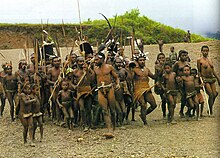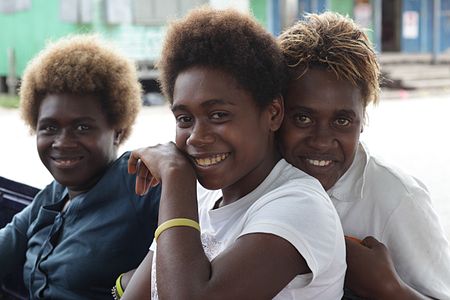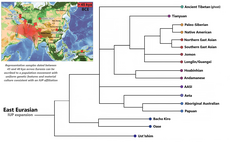Indigenous people of New Guinea
 Dani peoplefrom the central highlands of Western New Guinea, Indonesia | |
| Total population | |
|---|---|
| 14,800,000 | |
| Regions with significant populations | |
| Papua New GuineaandWestern New Guinea,Indonesia | |
| Languages | |
| Languages of Papua In Papuan New Guinea:Tok Pisin,Hiri Motu,UnserdeutschandEnglish In Indonesia:Papuan MalayandIndonesian | |
| Religion | |
| Christianity,Traditional Faiths | |
| Related ethnic groups | |
| OtherMelanesians,Ambonese,Moluccans,Aboriginal Australians,Malagasy people |
Theindigenous peoplesofWestern New GuineainIndonesiaandPapua New Guinea,commonly calledPapuans,[1]areMelanesians.There is genetic evidence for two major historical lineages in New Guinea and neighboring islands: a first wave from theMalay Archipelagoperhaps 50,000 years ago when New Guinea and Australia were a single landmass calledSahuland, much later, a wave ofAustronesian peoplefrom the north who introducedAustronesian languagesand pigs about 3,500 years ago. They also left a small but significant genetic trace in many coastal Papuan peoples.
Linguistically, Papuans speak languages from the many families ofnon-Austronesian languagesthat are found only on New Guinea and neighboring islands, as well asAustronesian languagesalong parts of the coast, and recently developed creoles such asTok Pisin,Hiri Motu,Unserdeutsch,andPapuan Malay.[2][3][4]
The term "Papuan" is used in a wider sense in linguistics and anthropology. In linguistics, "Papuan languages"is a cover term for the diverse, mutually unrelated, non-Austronesian language families spoken inMelanesia,theTorres Strait Islands,and parts ofWallacea.In anthropology, "Papuan" is often used to denote the highly diverse aboriginal populations of Melanesia and Wallacea prior to the arrival of Austronesian-speakers, and the dominant genetic traces of these populations in the current ethnic groups of these areas.[3]

Languages
[edit]
Ethnologue's 14th edition lists 826 languages ofPapua New Guineaand 257 languages ofWestern New Guinea,a total of 1083 languages, with 12 languages overlapping. They can be divided into two groups, theAustronesian languages,and all the others, calledPapuan languagesfor convenience. The termPapuan languagesrefers to anareal grouping,rather than a linguistic one. So-called Papuan languages comprise hundreds of different languages, most of which are not related.[5][6]
Papuan ethnic groups
[edit]
The following indigenous peoples live within the modern borders of Indonesia and Papua New Guinea. Austronesian-speaking (AN) groups are given initalics.
Indonesia
[edit]West Papua
[edit]Papuan ethnic groups / tribes in the Indonesian province of West Papua include Arfak, Borai, Doreri, Hatam, Irarutu, Koiwai, Kuri, Madewana, Mairasi, Maniwak, Mbaham, Matta, Meiah, Miere, Meyah, Moire, Moru, Moskona, Napiti, Oburauw, Roon, Roswar, Sebyar, Sougb, Soviar, Sumuri, Wamesa, Warumba, Waruri, Wondama.[7]
Southwest Papua
[edit]Papuan ethnic groups / tribes in the Indonesian province of Southwest Papua include Abun, Ambel, Batanta, Biak (Betew, Kafdaron, Bikar, Usba, Wardo), Biga, Butlih, Domu, Fiawat, Imekko (Inanwatan-Bira, Matemani-Iwaro, Kais-Awe, Kokoda-Emeyode), Irires, Ma'ya (Kawe, Langanyan, Wawiyai), Matbat, Maybrat (Ayamaru, Mare, Karon Dori, Ayfat, Aytinyo), Meyah, Moi-Ma'ya, Moi, Mpur, Nerigo,Tehit,Tepin, Yahadian, Yaben-Konda.[7]
Papua
[edit]Papuan ethnic groups/tribes in the Indonesian province of Papua include:[8]
| Jayapura City |
|
|---|---|
| Jayapura Regency |
|
| Sarmi Regency |
|
| Keerom Regency |
|
| Biak Numfor Regency |
|
| Waropen Regency |
|
| Yapen Islands Regency |
|
| Mamberamo Regency |
Highland Papua
[edit]Papuan ethnic groups/tribes in the Indonesian province ofHighland Papuainclude:[8]
| Jayawijaya Regency |
|
|---|---|
| Pegunungan Bintang Regency |
|
| Tolikara Regency |
|
| Yahukimo Regency |
|
Central Papua
[edit]Papuan ethnic groups/tribes in the Indonesian province ofCentral Papuainclude:[8]
| Mimika Regency |
|
|---|---|
| Nabire Regency[9] |
|
| Painai Regency | |
| Puncak Jaya Regency |
|
South Papua
[edit]Papuan ethnic groups/tribes in the Indonesian province ofSouth Papuainclude:[8]
| Merauke Regency |
|
|---|---|
| Asmat Regency | |
| Mappi Regency |
|
| Boven Digoel Regency |
Papua New Guinea
[edit]Bismarck Archipelago
[edit]-
Girls from Papua New Guinea
-
Papuan people infolk dressinJakarta
-
Newly married Kayu Batu couple inJayapura,Indonesia
Origin and genetics
[edit]The origin of Papuans is generally associated with the first settlement ofAustralasiaby a lineage dubbed 'Australasians' or 'Australo-Papuans' during theInitial Upper Paleolithic,which is "ascribed to a population movement with uniform genetic features and material culture" (Ancient East Eurasians), and sharing deep ancestry with modernEast Asian peoplesand other Asia-Pacific groups.[10][11][12]It is estimated that people reachedSahul(the geological continent consisting of Australia and New Guinea) between 50,000 and 37,000 years ago. Rising sea levels separated New Guinea from Australia about 10,000 years ago. However, Aboriginal Australians and Papuans had diverged genetically much earlier, around 40,000 years BP. Papuans are more closely related toMelanesiansthan to Aboriginal Australians.[13][12]
Haplogroups
[edit]The majority of PapuanY-DNAHaplogroups belong to subclades ofHaplogroupMS,andHaplogroupC1b2a.The frequency of each haplogroup varies along geographic clines.[14][15]
Autosomal DNA
[edit]The genetic makeup of Papuans is primarily derived fromAncient East Eurasians,which relates them to other mainland Asian groups such as the "AASI",Andamanese, as well as East/Southeast Asians, although Papuans may have also received some gene flow from an earlier group (xOoA), around 2%,[16]next to additional archaicDenisovanadmixture in theSahulregion. Papuans may habor varying degrees of deep admixture from "a lineage basal to West and East-Eurasians which occurred sometimes between 45 and 38kya", although they are generally regarded "as a simple sister group ofTianyuan"(" Basal East Asians ").[11][12][10]

There is evidence that the ancestors of Papuans and related groups "underwent a strong bottleneck before the settlement of the region, and separated around 20,000–40,000 years ago".[17]
Papuans display pronounced genetic diversity, explained through isolation and drift between different subgroups after the settlement ofNew Guinea.The most notable differentiation was found to be between Highlanders and Lowlanders. Papuan Highlanders fall into three clusters, but form a single clade compared against Lowlanders. The Highlanders underwent a population bottleneck around 10,000 years ago, associated with the adoption of Neolithic lifestyles. Papuan Lowlanders display increased diversity and can be broadly differentiated into a Southern Lowlander cluster and a Northern Lowlander cluster. The genetic differentiation among Papuans is suggested to date back at least 20kya, while the sub-structure among Highlanders dates back around 10kya, with higher diversity among western Highlanders than Eastern ones. The genetic diversity is paralleled by linguistic and cultural diversity.[18]
Archaic introgression
[edit]Based on his genetic studies of theDenisova hominin,an ancient human species discovered in 2010,Svante Pääboclaims thatancient human ancestors of the Papuans interbred in Asia with these humans.He has found that people of New Guinea share 4%–7% of their genome with the Denisovans, indicating this exchange.[19]Denisovan introgressions may have influenced the immune system of present-day Papuans and potentially favoured "variants to immune-related phenotypes" and "adaptation to the local environment".[20]
ASPM gene
[edit]In a 2005 study ofASPM gene variants,Mekel-Bobrov et al. found that the Papuan people have among the highest rate of the newly evolved ASPM HaplogroupD, at 59.4% occurrence of the approximately 6,000-year-oldallele.[21]While it is not yet known exactly what selective advantage is provided by this gene variant, the haplogroupD allele is thought to be positively selected in populations and to confer some substantial advantage that has caused its frequency to rapidly increase.
Notable people
[edit]- Abba Bina,Papua New Guinean businessman and politician
- Archie Thompson,former Australian soccer player
- Elie Aiboy,former Indonesian footballer
- Marlina Flassy,Indonesian anthropologist and the first woman to be appointed Dean ofCenderawasih University
- Frans Kaisiepo,4th Governor of Papua andNational Hero of Indonesia
- Nitya Krishinda Maheswari,Indonesian badminton player and2014 Asian Gameswomen's doubles gold medalist
- Nowela Auparay,professional singer andIndonesian Idolwinner
- Peter O'Neill,7thPrime Minister of Papua New Guinea
- Freddy Numberi,Indonesian politician and former Minister of Transportation
- Raema Lisa Rumbewas,Indonesian weightlifter and silver medallist at the2000and2004 Summer Olympics
- Boaz Solossa,Indonesian footballer
- Titus Bonai,Indonesian footballer
- Ricky Kambuaya,Indonesian footballer
- Michael Somare,formerPrime Minister of Papua New Guinea
- Heather Watson,English female tennis player
- Benny Wenda,West Papuan independence leader.
- Machmud Singgirei Rumagesan,King ofSekarandNational Hero of Indonesia
- Abdul Hakim Achmad Aituarauw,Member of People's Representative Council
- Alwin Komolong
- Kusuga Komolong
- Saiful Islam Al-Payage,Indonesian Islamic preacher
See also
[edit]- Aboriginal Australians
- Indigenous Australians
- Koteka Tribal Assembly
- List of ethnic groups of West Papua
- Malagasy people(Africa)
- Moluccans(to the west of New Guinea)
- Negrito(Southeast Asia)
- Papua conflict
- Proto-Australoid
- Stéphane Breton (filmmaker)
- Torres Strait Islandersbetween New Guinea and mainland Australia (including theMeriam people,whose language family is otherwise found in New Guinea)
References
[edit]- ^From the Malay wordpəpuah'curly hair'."Papuan".Oxford English Dictionary(Online ed.).Oxford University Press.(Subscription orparticipating institution membershiprequired.)
- ^Traditional Melanesiaat theEncyclopædia Britannica
- ^abFriedlaender J, Friedlaender FR, Reed FA, Kidd KK, Kidd JR (2008)."The Genetic Structure of Pacific Islanders".PLOS Genetics.4(3): e19.doi:10.1371/journal.pgen.0040019.PMC2211537.PMID18208337.
- ^Jinam, Timothy A.; Phipps, Maude E.; Aghakhanian, Farhang; Majumder, Partha P.; Datar, Francisco; Stoneking, Mark; Sawai, Hiromi; Nishida, Nao; Tokunaga, Katsushi; Kawamura, Shoji; Omoto, Keiichi; Saitou, Naruya (August 2017)."Discerning the Origins of the Negritos, First Sundaland People: Deep Divergence and Archaic Admixture".Genome Biology and Evolution.9(8): 2013–2022.doi:10.1093/gbe/evx118.PMC5597900.PMID28854687.
- ^Palmer, Bill (2018).The Languages and Linguistics of the New Guinea Area.Mouton De Gruyter.ISBN978-3-11-028642-7.
- ^"Forthcoming Series: Papuan Languages".Brill.Retrieved2023-12-14.
- ^abRonsumbre, Adolof (2020).Ensiklopedia Suku Bangsa di Provinsi Papua Barat.Yogyakarta: Penerbit Kepel Press.ISBN978-602-356-318-0.
- ^abcd"Pemerintah Provinsi Papua".papua.go.id.Retrieved2021-02-16.
- ^"Bupati Mesak Siap Bangun Asrama Siswa Suku Terasing di Nabire – Pemerintah Kabupaten Nabire".Pemerintah Kabupaten Nabire – "Nabire Aman, Mandiri dan Sejahtera".Retrieved2022-10-25.
- ^abTaufik, Leonard; Teixeira, João C.; Llamas, Bastien; Sudoyo, Herawati; Tobler, Raymond; Purnomo, Gludhug A. (December 2022)."Human Genetic Research in Wallacea and Sahul: Recent Findings and Future Prospects".Genes.13(12): 2373.doi:10.3390/genes13122373.ISSN2073-4425.PMC9778601.PMID36553640.
- ^abYang, Melinda A. (2022-01-06)."A genetic history of migration, diversification, and admixture in Asia".Human Population Genetics and Genomics.2(1): 1–32.doi:10.47248/hpgg2202010001.ISSN2770-5005.
- ^abcVallini, Leonardo; Marciani, Giulia; Aneli, Serena; Bortolini, Eugenio; Benazzi, Stefano; Pievani, Telmo; Pagani, Luca (2022-04-10)."Genetics and Material Culture Support Repeated Expansions into Paleolithic Eurasia from a Population Hub Out of Africa".Genome Biology and Evolution.14(4).doi:10.1093/gbe/evac045.ISSN1759-6653.PMC9021735.PMID35445261.
Taken together with a lower bound of the final settlement of Sahul at 37 kya it is reasonable to describe Papuans as either an almost even mixture between East-Eurasians and a lineage basal to West and East-Eurasians which occurred sometimes between 45 and 38kya, or as a sister lineage of East-Eurasians with or without a minor basal OoA or xOoA contribution. We here chose to parsimoniously describe Papuans as a simple sister group of Tianyuan, cautioning that this may be just one out of six equifinal possibilities.
- ^Pedro, Nicole; Brucato, Nicolas; Fernandes, Veronica; André, Mathilde; Saag, Lauri; Pomat, William; Besse, Céline; Boland, Anne; Deleuze, Jean-François; Clarkson, Chris; Sudoyo, Herawati; Metspalu, Mait; Stoneking, Mark; Cox, Murray P.; Leavesley, Matthew; Pereira, Luisa; Ricaut, François-Xavier (October 2020)."Papuan mitochondrial genomes and the settlement of Sahul".Journal of Human Genetics.65(10): 875–887.doi:10.1038/s10038-020-0781-3.PMC7449881.PMID32483274.
- ^Kỳ cốc, mãn."DNA・ khảo cổ ・ ngôn ngữ の học tế nghiên cứu が kỳ す tân ・ Nhật Bản quần đảo sử: Nhật Bản người tập đoàn ・ Nhật Bản ngữ の thành lập sử"[New History of the Japanese Archipelago Revealed by Interdisciplinary Research on DNA, Archeology, and Language].(No Title)(in Japanese).
- ^Kayser, Manfred; Brauer, Silke; Weiss, Gunter; Schiefenhövel, Wulf; Underhill, Peter; Shen, Peidong; Oefner, Peter; Tommaseo-Ponzetta, Mila; Stoneking, Mark (2003-02-01)."Reduced Y-Chromosome, but Not Mitochondrial DNA, Diversity in Human Populations from West New Guinea".The American Journal of Human Genetics.72(2): 281–302.doi:10.1086/346065.ISSN0002-9297.PMC379223.
- ^"Almost all living people outside of Africa trace back to a single migration more than 50,000 years ago".science.org.Retrieved2022-08-19.
- ^Choin, Jeremy; Mendoza-Revilla, Javier; Arauna, Lara R.; Cuadros-Espinoza, Sebastian; Cassar, Olivier; Larena, Maximilian; Ko, Albert Min-Shan; Harmant, Christine; Laurent, Romain; Verdu, Paul; Laval, Guillaume; Boland, Anne; Olaso, Robert; Deleuze, Jean-François; Valentin, Frédérique (April 2021)."Genomic insights into population history and biological adaptation in Oceania".Nature.592(7855): 583–589.doi:10.1038/s41586-021-03236-5.ISSN1476-4687.
- ^Bergström, Anders; Oppenheimer, Stephen J.; Mentzer, Alexander J.; Auckland, Kathryn; Robson, Kathryn; Attenborough, Robert; Alpers, Michael P.; Koki, George; Pomat, William; Siba, Peter; Xue, Yali; Sandhu, Manjinder S.; Tyler-Smith, Chris (2017-09-15)."A Neolithic expansion, but strong genetic structure, in the independent history of New Guinea".Science.357(6356): 1160–1163.doi:10.1126/science.aan3842.ISSN0036-8075.PMC5802383.PMID28912245.
- ^Carl Zimmer(22 December 2010)."Denisovans Were Neanderthals' Cousins, DNA Analysis Reveals".NYTimes.
- ^Vespasiani, Davide M.; Jacobs, Guy S.; Cook, Laura E.; Brucato, Nicolas; Leavesley, Matthew; Kinipi, Christopher; Ricaut, François-Xavier; Cox, Murray P.; Gallego Romero, Irene (2022-12-08)."Denisovan introgression has shaped the immune system of present-day Papuans".PLOS Genetics.18(12): e1010470.doi:10.1371/journal.pgen.1010470.ISSN1553-7390.PMC9731433.PMID36480515.
- ^Mekel-Bobrov, Nitzan; Gilbert, Sandra L.; Evans, Patrick D.; Vallender, Eric J.; Anderson, Jeffrey R.; Hudson, Richard R.; Tishkoff, Sarah A.; Lahn, Bruce T. (2005-09-09). "Ongoing Adaptive Evolution of ASPM, a Brain Size Determinant in Homo sapiens".Science.309(5741): 1720–1722.Bibcode:2005Sci...309.1720M.doi:10.1126/science.1116815.ISSN0036-8075.PMID16151010.S2CID30403575.
Further reading
[edit]- W. G. Lawes (1882),"New Guinea and Its People",Popular Science Monthly
External links
[edit] Media related toPeople of Papuaat Wikimedia Commons
Media related toPeople of Papuaat Wikimedia Commons




